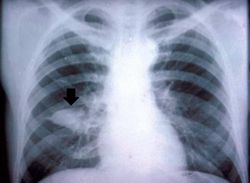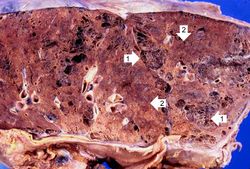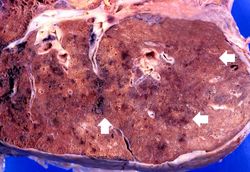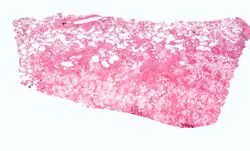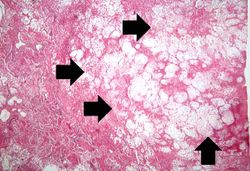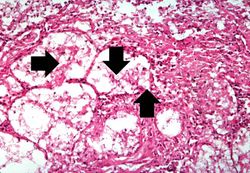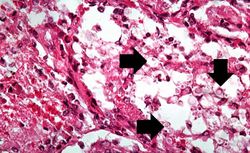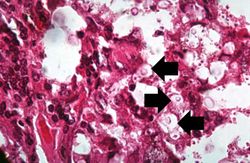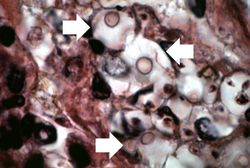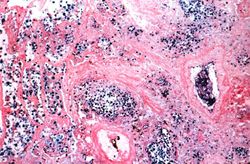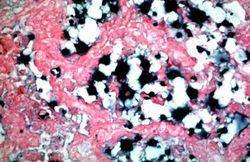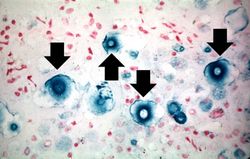Difference between revisions of "IPLab:Lab 10:Cryptococcosis"
(→Clinical Summary) |
|||
| (10 intermediate revisions by 2 users not shown) | |||
| Line 1: | Line 1: | ||
== Clinical Summary == | == Clinical Summary == | ||
| − | This 46-year-old male presented with a complaint of right-sided chest pain of six months duration. Chest x-ray showed a nodular mass in the lower lobe of the right lung. The mass was resected surgically. | + | This 46-year-old male presented with a complaint of right-sided chest pain of six months duration. Chest x-ray showed a nodular mass in the lower lobe of the right lung. The mass was resected surgically. |
| − | + | The 3.5 x 2.5-cm mass was firm, gray, and gelatinous. The mass proved to be a cryptococcal lesion. | |
| − | |||
| − | The 3.5 x 2.5-cm mass was firm, gray, and gelatinous. The mass proved to be a cryptococcal lesion. | ||
== Images == | == Images == | ||
| Line 22: | Line 20: | ||
File:IPLab10Crypto12.jpg|This is a touch prep of fresh lung tissue that was allowed to air dry and then stained to show the mucopolysaccharide capsule around the cryptococcal organisms (arrows). | File:IPLab10Crypto12.jpg|This is a touch prep of fresh lung tissue that was allowed to air dry and then stained to show the mucopolysaccharide capsule around the cryptococcal organisms (arrows). | ||
</gallery> | </gallery> | ||
| + | |||
| + | == Virtual Microscopy == | ||
| + | === H&E === | ||
| + | <peir-vm>IPLab10Crypto_HE</peir-vm> | ||
| + | |||
| + | === Mucicarmine === | ||
| + | <peir-vm>IPLab10Crypto_Muci</peir-vm> | ||
== Study Questions == | == Study Questions == | ||
| Line 39: | Line 44: | ||
(3) production of phenoloxidase an enzyme that consumes host epinephrine in the synthesis of fungal melanin and thus protects the fungi from the epinephrine oxidative system present in the host nervous system. | (3) production of phenoloxidase an enzyme that consumes host epinephrine in the synthesis of fungal melanin and thus protects the fungi from the epinephrine oxidative system present in the host nervous system. | ||
| + | It is thought that one reason why Cryptococcus neoformans preferentially infects the brain may be because the CSF lacks alternative pathway complement components (present in serum) that bind to the carbohydrate capsule and facilitate phagocytosis and killing by polymorphonuclear cells.</spoiler> | ||
| + | |||
| + | == Additional Resources == | ||
| + | === Reference === | ||
| + | * [http://emedicine.medscape.com/article/215354-overview eMedicine Medical Library: Cryptococcosis] | ||
| + | * [http://www.merckmanuals.com/professional/infectious_diseases/fungi/cryptococcosis.html Merck Manual: Cryptococcosis] | ||
| + | |||
| + | === Journal Articles === | ||
| + | * Rooney PJ, Klein BS. [http://www.ncbi.nlm.nih.gov/pubmed/11906450 Linking fungal morphogenesis with virulence]. ''Cell Microbiol'' 2002 Mar;4(3):127-37. | ||
| + | |||
| + | === Images === | ||
| + | * [{{SERVER}}/library/index.php?/tags/2157-cryptococcosis PEIR Digital Library: Cryptococcosis] | ||
| + | * [http://library.med.utah.edu/WebPath/INFEHTML/INFECIDX.html WebPath: Infection] | ||
| − | + | == Related IPLab Cases == | |
| + | * [[IPLab:Lab 5:α1 Antitrypsin Deficiency|Lab 5: Lung: α1-Antitrypsin Deficiency]] | ||
| + | * [[IPLab:Lab 12:COPD|Lab 12: Lung: Chronic Obstructive Pulmonary Disease]] | ||
{{IPLab 10}} | {{IPLab 10}} | ||
[[Category: IPLab:Lab 10]] | [[Category: IPLab:Lab 10]] | ||
Latest revision as of 21:54, 9 July 2020
Contents
Clinical Summary[edit]
This 46-year-old male presented with a complaint of right-sided chest pain of six months duration. Chest x-ray showed a nodular mass in the lower lobe of the right lung. The mass was resected surgically.
The 3.5 x 2.5-cm mass was firm, gray, and gelatinous. The mass proved to be a cryptococcal lesion.
Images[edit]
Virtual Microscopy[edit]
H&E[edit]
Mucicarmine[edit]
Study Questions[edit]
Additional Resources[edit]
Reference[edit]
Journal Articles[edit]
- Rooney PJ, Klein BS. Linking fungal morphogenesis with virulence. Cell Microbiol 2002 Mar;4(3):127-37.
Images[edit]
Related IPLab Cases[edit]
| |||||
Nodular hyperplasia of the prostate--characterized by large discrete prostatic nodules--is a common disorder in men over 50 years of age. The nodules cause the prostate to be enlarged and to have an increased weight. The human prostate is surrounded by a restrictive capsule. These nodules cause increased pressure within the capsule which leads to constriction of the urethra as it passes through the prostate. Urethral constriction leads to retention of urine.
Pulmonary emphysema is a condition in which the air spaces distal to the terminal bronchioles are permanently increased in size due to either destruction of the wall or alveolar dilatation.
